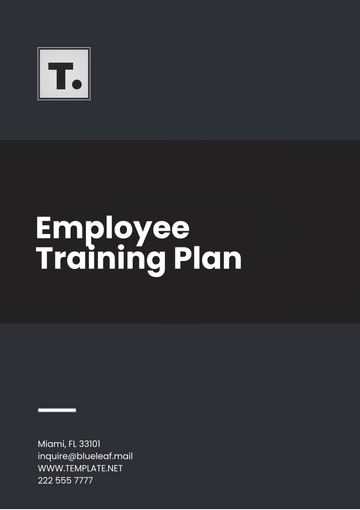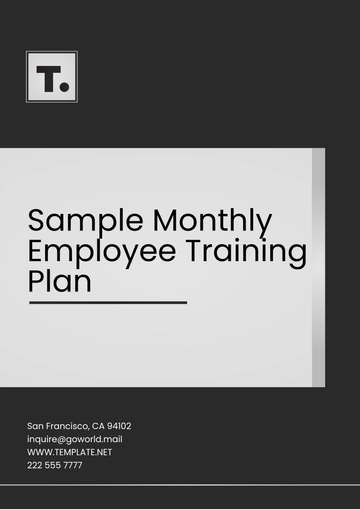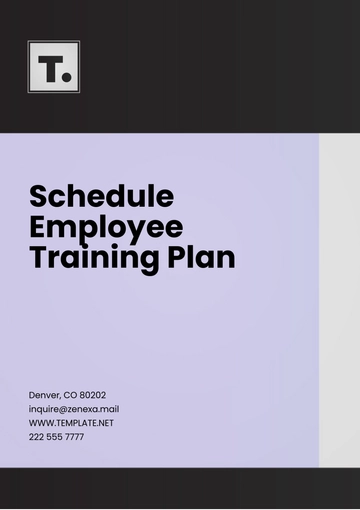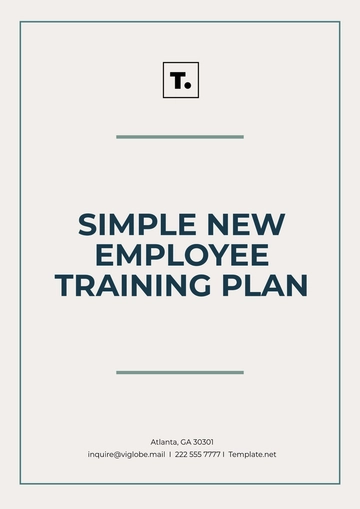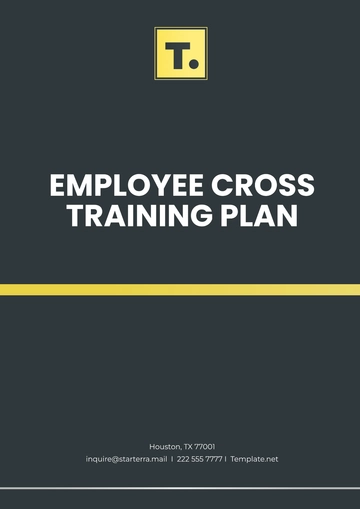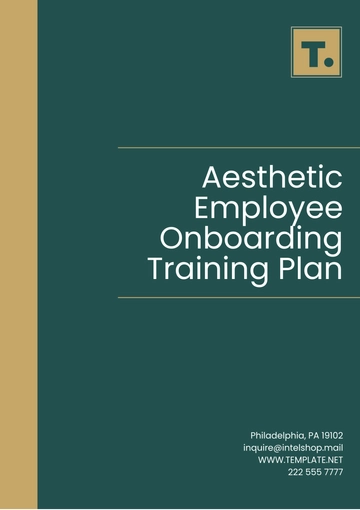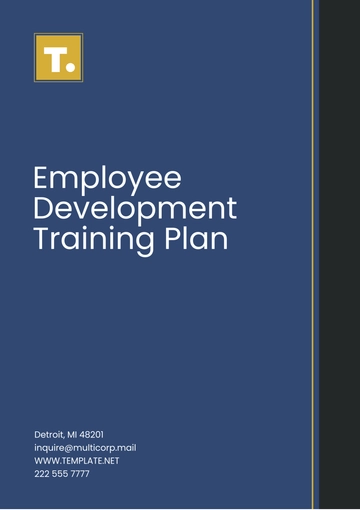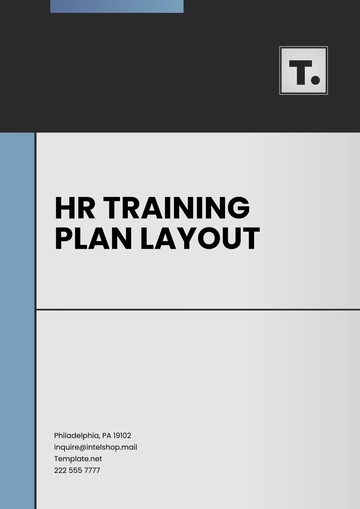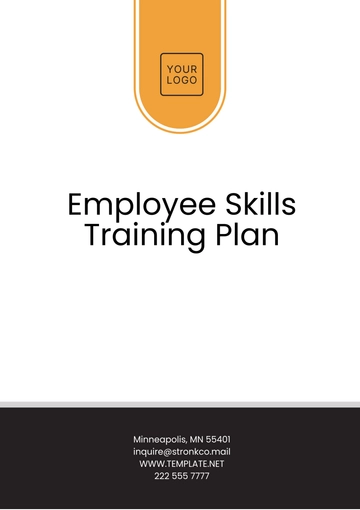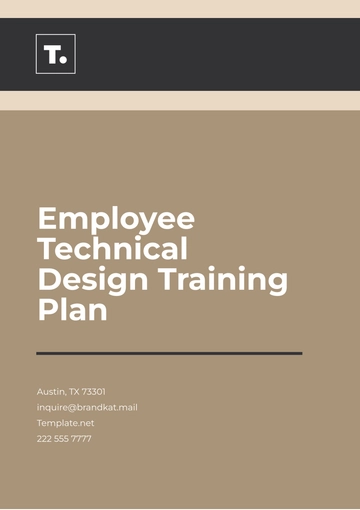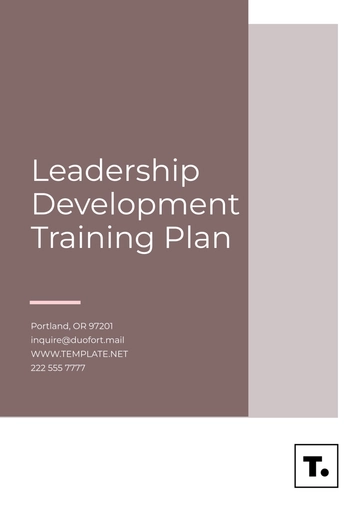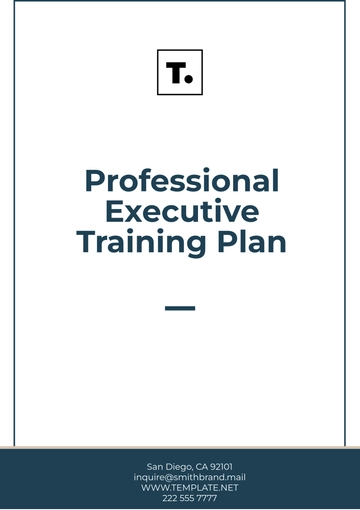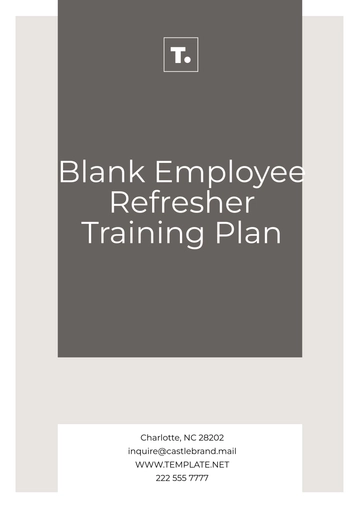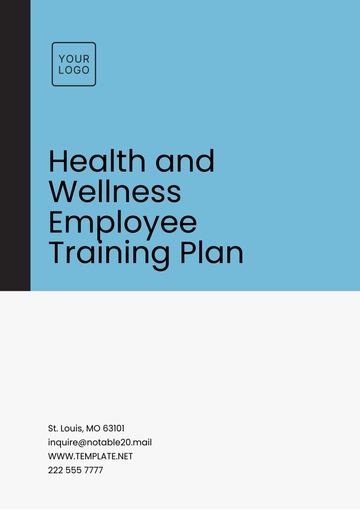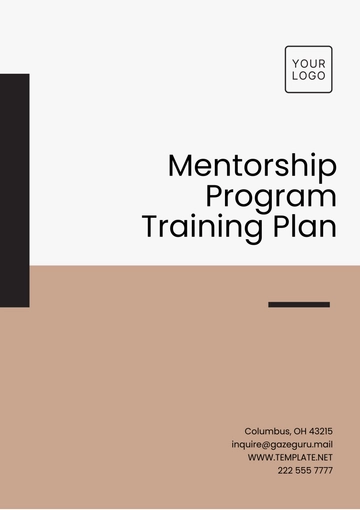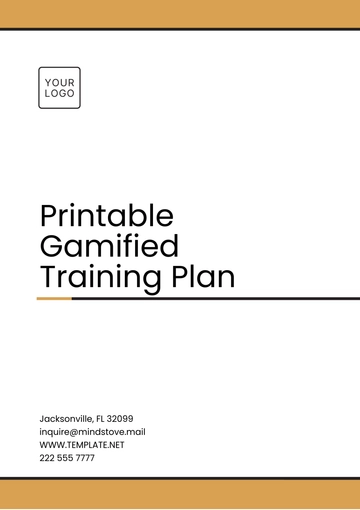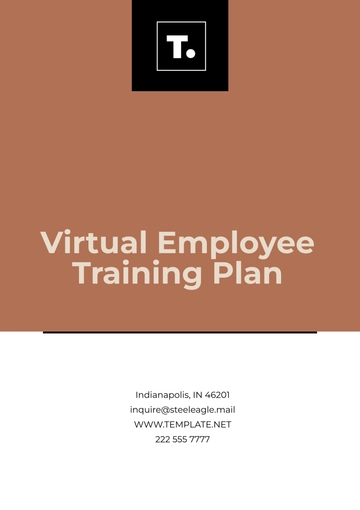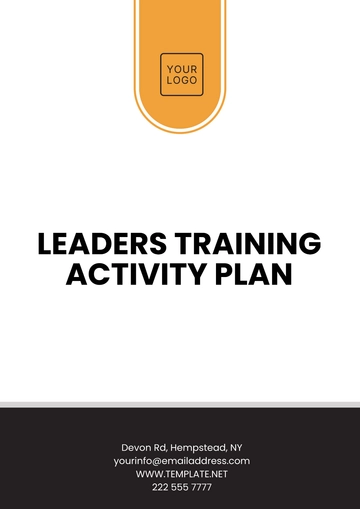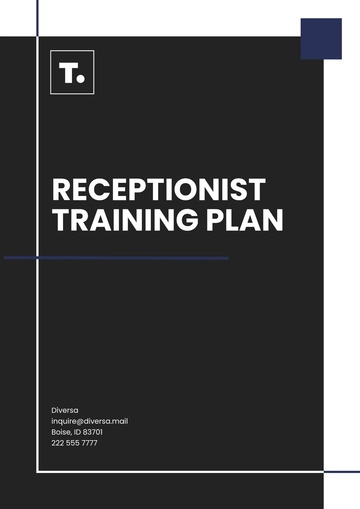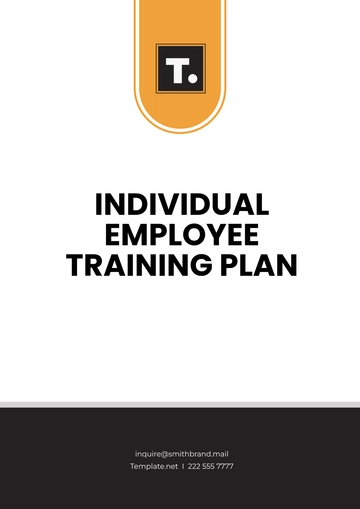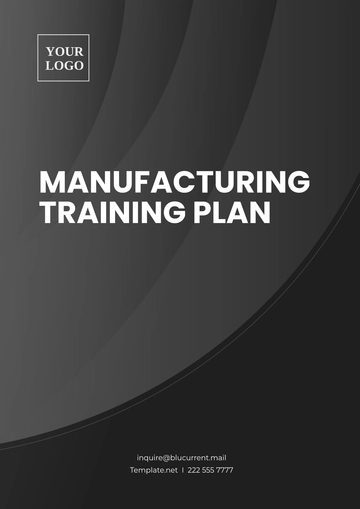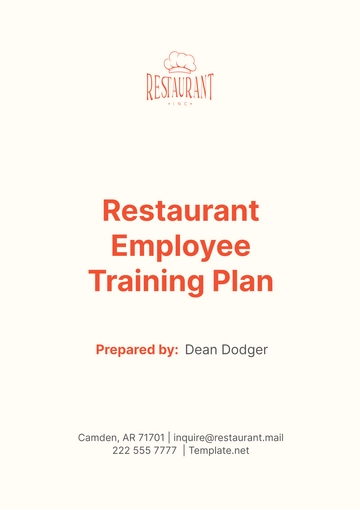Free Aesthetic Employee Onboarding Training Plan
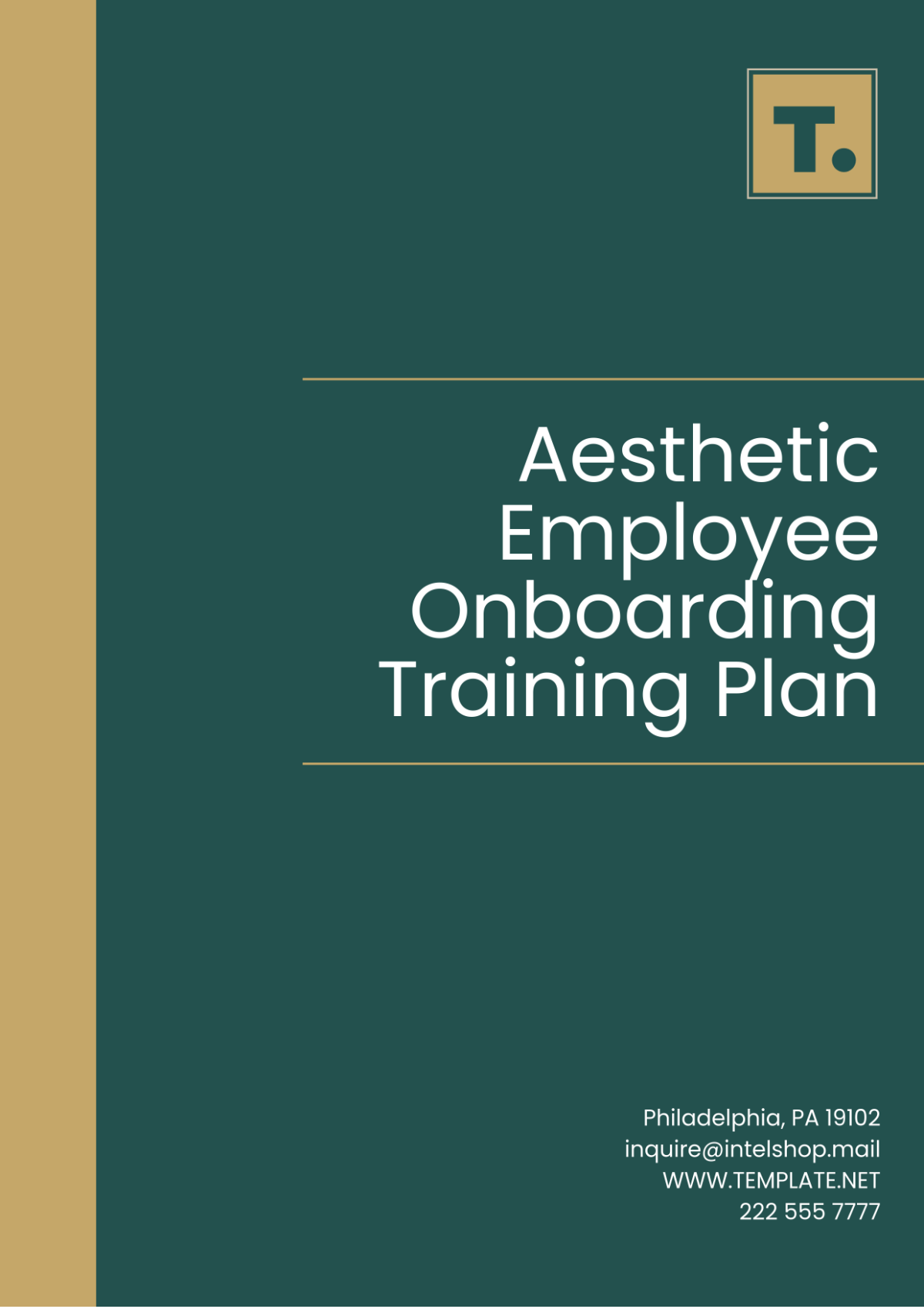
I. Introduction
The Employee Onboarding Training Plan equips new hires with essential skills, knowledge, and resources for a successful career start. This plan integrates new employees into our culture, promotes understanding of their roles, and supports them in aligning with company goals. This onboarding period is designed to make employees feel valued and empowered from day one.
II. Training Objectives
A. Enhance Skill Sets
Objective: Develop proficiency in essential skills for the employee's role.
Example: For a new marketing analyst, this includes skills in data analysis, SEO, and content strategy.
B. Foster Cultural Integration
Objective: Familiarize new hires with company values, mission, and work culture.
Example: Conduct sessions on our “Customer First” value, where employees learn how we prioritize customer experience.
C. Improve Job Performance
Objective: Provide knowledge and tools for effective performance in their role.
Example: Equip customer support representatives with a knowledge base on common queries, response templates, and customer relationship tools.
D. Build Relationships
Objective: Foster relationships across teams and departments.
Example: Organize a “Coffee Connect” session for new hires to meet with team leads from different departments.
III. Training Schedule
Day | Activity | Description |
|---|---|---|
Day 1 | Welcome and Orientation | Morning: Overview of company policies, mission, and values. Introduction to team and organizational structure. Afternoon: Administrative setup (e.g., email, software access) and benefits overview. |
Day 2 | Department Introduction | Meet with the department team, introduction to department goals, and a walkthrough of current projects and priorities. |
Day 3-5 | Role-Specific Training | Hands-on training with a mentor. Includes learning key tools (e.g., CRM for sales teams, analytics software for marketing) and shadowing on day-to-day tasks. |
Day 6 | Review and Assessment | Informal feedback session with the manager and mentor to assess understanding and comfort level with responsibilities. |
IV. Training Content
A. Company Overview
History and Milestones: Presentation on the company’s journey from a startup to an industry leader, including recent achievements and upcoming milestones.
Mission and Values: Deep dive into our mission to “Drive Innovation and Customer Success” and our core values like Integrity, Accountability, and Excellence.
Organizational Structure: Overview of each department’s role in achieving company goals, including key leaders and department heads.
B. Role-Specific Tools and Software
Technical Systems Overview: For example, for a finance role, an introduction to financial reporting systems like SAP and invoice processing software.
Software Training Modules: Interactive training on essential software. Sales employees might complete modules on our CRM (e.g., Salesforce) with practice exercises for entering and tracking leads.
C. Customer Service Excellence
Customer Interaction Guidelines: Cover best practices for customer engagement, response etiquette, and communication standards.
Handling Complaints and Feedback: Training on managing difficult conversations and resolving complaints, including role-playing exercises and case studies.
D. Compliance and Security Awareness
Data Privacy and Security Policies: Introduction to data security protocols, including password management, secure data storage, and information sharing policies.
Legal and Ethical Considerations: Explanation of policies such as anti-harassment, equal opportunity employment, and ethical reporting guidelines.
E. Health and Safety Protocols
Workplace Safety Procedures: Training on emergency evacuation procedures, first-aid resources, and pandemic-related health protocols.
Employee Well-Being: Overview of wellness programs, mental health support resources, and remote work flexibility options.
V. Assessment and Feedback
A. Progress Assessment
Checkpoints: Regular check-ins on days 3, 5, and 10 to discuss accomplishments and challenges.
Formal Evaluation: A 30-day review with the supervisor to assess job competency and review key performance indicators (KPIs).
B. Feedback Mechanism
Employee Feedback: Weekly anonymous surveys to gauge satisfaction with training and readiness for tasks.
Structured Feedback: End-of-onboarding feedback meeting to discuss suggestions for improving the onboarding experience.
C. Performance Review (Post-Onboarding)
Review Period: A 60-day formal performance review with specific goals and developmental feedback.
Long-Term Goals: Create a personal development plan aligned with career aspirations and departmental goals.
VI. Mentorship and Support
A. Buddy System
Assignment: New hires are paired with a buddy from their team who provides informal guidance on tasks, team culture, and resources.
Check-Ins: Regular catch-up meetings (bi-weekly) to address questions, build confidence, and offer support.
B. Ongoing Development
Training Access: Provide access to our Learning Management System (LMS) with a library of professional development courses.
Career Development Plans: Employees are encouraged to create long-term goals and work with their manager on a plan to achieve them.
VII. Cultural and Team Building Activities
A. Social Integration
Welcome Lunch: Host a team lunch in the first week to introduce the new hire to colleagues and leaders in a relaxed environment.
Employee Resource Groups (ERGs): Encourage participation in ERGs, such as Women in Tech, Diversity & Inclusion, and other interest groups.
B. Diversity and Inclusion Initiatives
Training on Cultural Awareness: Workshops to promote understanding and appreciation of cultural differences in the workplace.
Inclusive Environment: Host quarterly discussions on diversity topics, including unconscious bias, inclusion, and equitable practices.
VIII. Conclusion
The Employee Onboarding Training Plan is essential to preparing new hires for long-term success. By blending structured training, skills development, cultural integration, and continuous support, this plan provides a comprehensive onboarding experience. Feedback gathered from employees during and after their onboarding will allow us to refine the process and ensure the training is both effective and engaging.
- 100% Customizable, free editor
- Access 1 Million+ Templates, photo’s & graphics
- Download or share as a template
- Click and replace photos, graphics, text, backgrounds
- Resize, crop, AI write & more
- Access advanced editor
Streamline new hires' journeys with Template.net’s Aesthetic Employee Onboarding Training Plan Template. This customizable and editable template is designed for a visually engaging onboarding experience. Fully editable in our AI Editor Tool, it’s perfect for tailoring to your brand’s needs, ensuring a seamless, professional start for your team. Get started today at Template.net!
You may also like
- Finance Plan
- Construction Plan
- Sales Plan
- Development Plan
- Career Plan
- Budget Plan
- HR Plan
- Education Plan
- Transition Plan
- Work Plan
- Training Plan
- Communication Plan
- Operation Plan
- Health And Safety Plan
- Strategy Plan
- Professional Development Plan
- Advertising Plan
- Risk Management Plan
- Restaurant Plan
- School Plan
- Nursing Home Patient Care Plan
- Nursing Care Plan
- Plan Event
- Startup Plan
- Social Media Plan
- Staffing Plan
- Annual Plan
- Content Plan
- Payment Plan
- Implementation Plan
- Hotel Plan
- Workout Plan
- Accounting Plan
- Campaign Plan
- Essay Plan
- 30 60 90 Day Plan
- Research Plan
- Recruitment Plan
- 90 Day Plan
- Quarterly Plan
- Emergency Plan
- 5 Year Plan
- Gym Plan
- Personal Plan
- IT and Software Plan
- Treatment Plan
- Real Estate Plan
- Law Firm Plan
- Healthcare Plan
- Improvement Plan
- Media Plan
- 5 Year Business Plan
- Learning Plan
- Marketing Campaign Plan
- Travel Agency Plan
- Cleaning Services Plan
- Interior Design Plan
- Performance Plan
- PR Plan
- Birth Plan
- Life Plan
- SEO Plan
- Disaster Recovery Plan
- Continuity Plan
- Launch Plan
- Legal Plan
- Behavior Plan
- Performance Improvement Plan
- Salon Plan
- Security Plan
- Security Management Plan
- Employee Development Plan
- Quality Plan
- Service Improvement Plan
- Growth Plan
- Incident Response Plan
- Basketball Plan
- Emergency Action Plan
- Product Launch Plan
- Spa Plan
- Employee Training Plan
- Data Analysis Plan
- Employee Action Plan
- Territory Plan
- Audit Plan
- Classroom Plan
- Activity Plan
- Parenting Plan
- Care Plan
- Project Execution Plan
- Exercise Plan
- Internship Plan
- Software Development Plan
- Continuous Improvement Plan
- Leave Plan
- 90 Day Sales Plan
- Advertising Agency Plan
- Employee Transition Plan
- Smart Action Plan
- Workplace Safety Plan
- Behavior Change Plan
- Contingency Plan
- Continuity of Operations Plan
- Health Plan
- Quality Control Plan
- Self Plan
- Sports Development Plan
- Change Management Plan
- Ecommerce Plan
- Personal Financial Plan
- Process Improvement Plan
- 30-60-90 Day Sales Plan
- Crisis Management Plan
- Engagement Plan
- Execution Plan
- Pandemic Plan
- Quality Assurance Plan
- Service Continuity Plan
- Agile Project Plan
- Fundraising Plan
- Job Transition Plan
- Asset Maintenance Plan
- Maintenance Plan
- Software Test Plan
- Staff Training and Development Plan
- 3 Year Plan
- Brand Activation Plan
- Release Plan
- Resource Plan
- Risk Mitigation Plan
- Teacher Plan
- 30 60 90 Day Plan for New Manager
- Food Safety Plan
- Food Truck Plan
- Hiring Plan
- Quality Management Plan
- Wellness Plan
- Behavior Intervention Plan
- Bonus Plan
- Investment Plan
- Maternity Leave Plan
- Pandemic Response Plan
- Succession Planning
- Coaching Plan
- Configuration Management Plan
- Remote Work Plan
- Self Care Plan
- Teaching Plan
- 100-Day Plan
- HACCP Plan
- Student Plan
- Sustainability Plan
- 30 60 90 Day Plan for Interview
- Access Plan
- Site Specific Safety Plan
